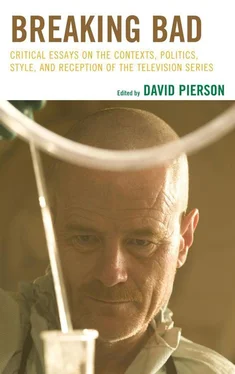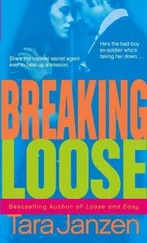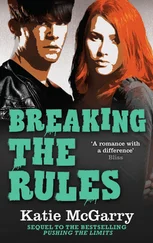Sternberg, Meir. Expositional Modes & Temporal Ordering in Fiction . Baltimore & London: The Johns Hopkins University Press, 1978.
Weinman, Jaime.“Should We Watch TV Shows From the Beginning?.” TV Guidance. 2011. http://www2.macleans.ca/2011/03/07/should-we-watch-tv-shows-from-the-beginning/.
Chapter 9
BUYING THE HOUSE: PLACE IN BREAKING BAD
Ensley F. Guffey
In the past five years, AMC’s critically acclaimed series Breaking Bad has become known for its compelling storytelling. Relying heavily on its diegetic history to develop its plot, Breaking Bad uses one of the most fundamental of human experiences to provide a framework of narrative memory: the ability to intentionally create meaningful places. This use of place contributes significantly to the emotional realism of the series by drawing on the viewer’s own phenomenological experience of the world. This essay will examine the homes of Jesse Pinkman and the White family; the three labs used in the show by Walt and Jesse to produce crystal meth; and the desert landscape seen throughout the series to demonstrate the manner in which Breaking Bad uses experiences of place and space to create a more fully realized diegetic world.
The concepts of “place” and “space” as used here draw upon theories of humanist geography. As developed in the mid-1970s, humanist geography was in part driven by the need to redefine place as something more than mere location or an ideographic space of concern only to a particular place, time, or people. Instead, humanist geographers sought to realize an idea of place which was “a universal and transhistorical part of the human condition” (Cresswell 2004, 20). To do so, scholars turned toward phenomenological and existential philosophy to develop a theory which depends upon subjective human experiences to give places meaning. As Edward Relph (1976) writes, “a place is not just the ‘where’ of something; it is the location plus everything that occupies that location seen as an integrated and meaningful phenomenon” (3). This intentional process of imbuing a given place with meaning is seen as an inherent part of the human experience of the world, and this relationship between human experience and place is encapsulated by such common sentiments as “making a house a home “or “this is where I grew up.”
Humanist geographers consider the concepts of place and space as being closely related yet partaking of different experiences. According to Yi-Fu Tuan (1977) “the ideas ‘space’ and ‘place’ require each other for definition: From the security and stability of place we are aware of the openness, freedom, and threat of space, and vice versa” (6). In Place and Placelessness, Relph (1976) links the two ideas even more closely arguing that “however we feel or know or explain space, there is nearly always some associated sense or concept of place. In general it seems that space provides the context for places but derives its meaning from particular places” (8). Both agree, however, that space is the more abstract of the two ideas, and is far more suggestive of the unknown and undifferentiated. Tim Cresswell (2004) sums up the essential difference as one where space is “a realm without meaning. When humans invest meaning in a portion of space and then become attached to it in some way… it becomes a place” (10). For example, when we rent a new, unfurnished apartment, we often view it as an empty space, full of potential, perhaps, but still unrealized. As we move in, decorate, cook, spill drinks, argue, make love, get sick, become well, celebrate, mourn, eat, sleep, eliminate, and perform all the other ordinaries of human existence, the empty space becomes our space, our place . Our experiences within the space give it a meaning, importance, and significance which, while admittedly subjective, are all central to our sense of place.
9809 MARGO STREET: JESSE PINKMAN’S HOME
Of all the places experienced by human beings, home is perhaps the most meaningful. Relph (1976) states that “home is the foundation of our identity as individuals and as members of a community, the dwelling place of being…. Home is… an irreplaceable centre [ sic ] of significance” (39). In season one of Breaking Bad , Jesse’s home is a place imbued with the personal history of his Aunt Jenny, her struggle with cancer, and her relationship with Jesse, whom she apparently took in when his parents kicked him out of their house for using drugs. Although in seasons one and two Jesse considers the house to be his place, in reality, it is his aunt’s memory and history which predominate. The décor is dark, feminine, and floral; there are delicate knick-knacks on the shelves, and doilies on the furniture. Though Jesse undoubtedly inhabits more of the house than when his aunt was alive, even in his upstairs bedroom Jesse’s presence remains minimal, and is largely confined to a few possessions strewn atop his aunt’s lingering order. The house is therefore in a transitional state. Jesse lives there as he did while his Aunt Jenny was still alive, but is only slowly creating a history and meaning separate from those which he shared with her. Jesse has yet to wholly remake his aunt’s place into his own.
In humanist geographic theory, “home is an exemplarily kind of place where people feel a sense of attachment and rootedness. Home, more than anything else, is seen as a center of meaning and a field of care” (Cresswell 2004, 24). In Jesse’s case, this idea of home as a field of care grows out of his experience of his aunt’s love. Michael A. Godkin (1980) suggests that, as a person struggling with addiction, the house at 9808 Margo Street would be particularly important to Jesse as a refuge, a safe place where Jesse “escapes an otherwise unhappy existence,” and Jesse does indeed display a profound sense of belonging and attachment to this particular place (77). The fact that Jesse has not made any real attempt to modify the décor is evidence of a desire to remember Jenny, and to maintain his home as it was when she was alive, with all the existing associations of safety and security.
Will he or won’t he, Jesse’s new relationship with Walter White quickly forces significant changes to Jesse’s home. Although Jesse seems to have been very careful to keep his meth-cooking activities well separated from his home, one of the first things to come out of Jesse’s new partnership with Walt is the storage of equipment for meth manufacture in his garage. When Walt suggests that they cook at Jesse’s house, Jesse reacts strongly, “No. We’re not gonna cook here. ‘Kay? This is my house . I don’t shit where I eat” (“Pilot” 01/20/08). This fits in well with Cresswell’s (2004) observation that home is a place of withdrawal and rest from the outside world where one has some degree of control over what happens. By the series’ second episode “The Cat’s in the Bag…” (01/27/08), Jesse’s home has largely passed beyond his control, and rather than a place of rest it has become a place of increasing tension and danger.
The inevitable and increasing encroachment of Walt and Jesse’s criminal activities into their personal and private lives is a major theme in Breaking Bad . This growing domination is often shown by the intrusion of Jesse and Walt’s illegal adventures into their respective homes. In relating the arrangement of a house to the human psyche, the French philosopher Gaston Bachelard (1964) gives particular places within a house a psychological equivalent (17-20). The invasion and changing of Jesse’s home by the darker, criminal elements of his life therefore becomes a reflection of his psychological state as he moves more deeply into that life. For Jesse, this psycho-spatial invasion begins immediately, for in Bachelard’s theory of place, the basement is a kind of spatial manifestation of the subconscious, and of nightmares (1964, 18). Krazy-8’s imprisonment and killing in Jesse’s basement in the second and third episodes of season one (“The Cat’s in the Bag…” 01/27/08) and “…And the Bag’s in the River” (02/10/08), and the later use of the same place as a temporary lab to manufacture precursor in “A No-Rough-Stuff-Type Deal” (03/09/08) are events which signal the rapidly growing influence of the chaotic and immoral over Jesse’s life—and his home.
Читать дальше












